The cost of roller shades for businesses in 2025 changes a lot. There is no single price. Many things affect it, like the size, fabric, and how they work.
The cost of commercial roller shades in 2025 depends on dimensions, fabric type (blackout, solar screen, fire-retardant), material, and operational system (manual, motorized). Shadesmart helps businesses balance budget and performance by providing detailed cost breakdowns and guiding material and operational choices for optimal solutions.
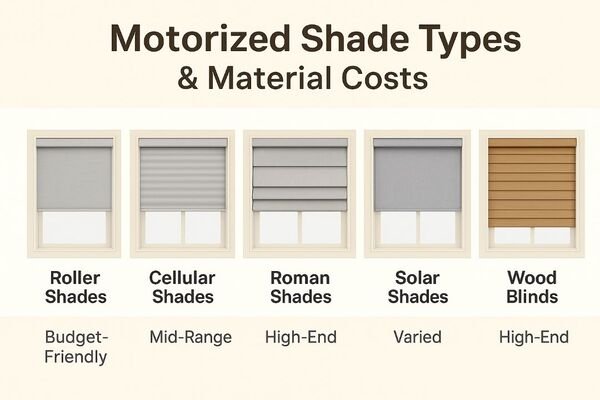
I know that understanding the cost of roller shades for commercial projects in 2025 can feel complex. There are many variables that influence the final price. This guide helps me explain these factors, providing clarity on how to budget effectively and make informed decisions for my clients.
What factors primarily influence the pricing of commercial roller shades?
Are you wondering why the price of roller shades for your business changes so much? Many things make the cost go up or down.
The pricing of commercial roller shades is primarily influenced by their dimensions (width and height), selected fabric type (opacity, composition, performance features like fire-retardancy), the operational mechanism (manual vs. motorized), complexity of the control system, and specific installation requirements.
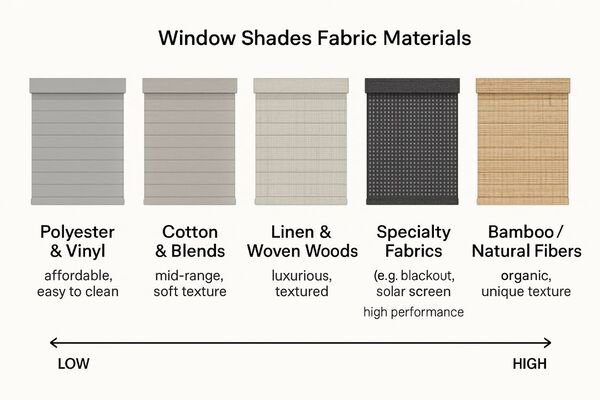
From my experience, several key factors primarily influence the pricing of commercial roller shades. First, dimensions are fundamental. Larger windows require more fabric and larger, more robust hardware, which directly increases the cost. A small office window will naturally be less expensive than a large curtain wall in a lobby. Second, the fabric type plays a very significant role. Basic translucent fabrics are more affordable than specialized options. High-performance fabrics, such as solar screens (which manage glare and heat while maintaining a view), blackout fabrics (for complete darkness), or fabrics with specific commercial certifications (like NFPA 701 fire-retardant ratings or antimicrobial properties for healthcare spaces), will increase the total price. Third, the operational mechanism is a major cost driver. Manual chain-operated or spring-assisted systems are the most budget-friendly. However, any form of motorization, whether battery-powered or wired, will significantly increase the cost. Motorized systems also vary in price based on the motor's power, noise level, and smart features. Fourth, the complexity of the control system for motorized shades adds to the price. Simple remote controls are less expensive than integration with a building management system (BMS) or advanced smart home platforms (like Control4, Crestron, or Lutron), which provide centralized control and scheduling capabilities. Finally, specific installation requirements, such as very high windows, difficult-to-access areas, or unique mounting solutions, can also impact labor costs. Shadesmart offers a consultation to break down these elements.
| Pricing Factor | Description | Impact on Roller Shade Cost |
|---|---|---|
| Shade Dimensions | Width and height of each individual shade. | Larger shades require more material and robust hardware, increasing cost. |
| Fabric Type | Opacity (sheer, translucent, blackout), material composition, performance features. | Specialized fabrics (solar screen, fire-retardant) raise the price. |
| Operational Mechanism | Manual chain/spring-assisted vs. motorized (battery, wired). | Motorization significantly increases cost, manual is cheapest. |
| Motor Features | Motor power, noise level (standard vs. whisper-quiet), smart capabilities. | Advanced, quieter, or smart motors cost more. |
| Control System | Remote, wall switch, app control, integration with BMS/smart home systems. | Integration with complex systems significantly adds to cost. |
| Installation Complexity | Window height, accessibility, wiring requirements, number of shades. | Difficult installations increase labor costs. |
How do fabric selections and operational mechanisms impact overall cost?
Are you wondering how the fabric you choose and the way your shades work affect their price? Both choices make a big difference.
Fabric selections impact overall cost through material composition, performance features (fire-retardancy, energy efficiency, UV protection), and aesthetic premium. Operational mechanisms affect cost based on manual vs. motorization, power source (battery vs. wired), and smart control integration, where advanced options significantly raise the price.
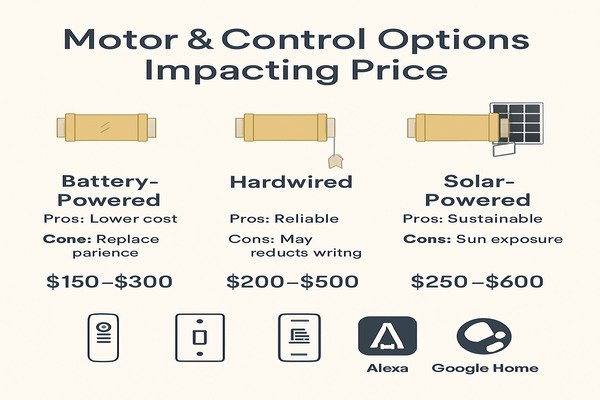
I know that fabric selections and operational mechanisms are two of the most significant drivers of overall cost for commercial roller shades. Starting with fabric selections, the choice of material greatly influences the price. Basic polyester or PVC fabrics are generally more economical. However, once I start looking at fabrics with specific performance features, the cost increases. For example, highly energy-efficient fabrics designed to reduce solar heat gain can be pricier but offer long-term energy savings. Fire-retardant fabrics, which are often a regulatory requirement for commercial spaces (meeting NFPA 701 standards), also come at a premium due to their specialized treatment. Similarly, aesthetic considerations like unique textures, patterns, or custom colors can add to the fabric cost. Shadesmart offers a wide range of performance and aesthetic fabrics. Turning to operational mechanisms, the choice between manual and motorized is a critical cost point. Manual chain-driven or spring-assisted systems are the most cost-effective. These are simple, reliable, and require no electrical work. Motorized systems, however, involve the cost of the motor itself, which varies based on its brand, power, and noise level (whisper-quiet motors are more expensive). The power source for motors also impacts cost; battery-powered motors reduce electrical installation costs but have ongoing battery replacement expenses, while wired motors have higher initial installation costs for wiring but offer continuous power. Finally, integrating motors with smart home or building management systems through specific control interfaces adds another layer of cost due to the technology and programming involved for centralized control and automation.
| Component | Cost Impact | Performance/Aesthetic Impact |
|---|---|---|
| Basic Fabric | Lower cost | Standard light control, basic aesthetics. |
| Performance Fabric | Higher cost (e.g., fire-retardant, antimicrobial, high energy efficiency) | Meets commercial regulations, enhanced comfort, energy savings. |
| Premium Aesthetic Fabric | Higher cost (e.g., unique textures, custom patterns, designer colors) | Elevates interior design, creates specific ambiance. |
| Manual Mechanism | Lowest cost (chain, spring-assist) | Simple operation, no electrical requirements. |
| Battery Motorization | Mid-range cost, lower electrical installation | Wireless, convenient, needs battery replacement. |
| Wired Motorization | Higher cost (motor + electrical installation) | Continuous power, highly reliable, no battery maintenance. |
| Whisper-Quiet Motor | Higher cost | Silent operation, ideal for noise-sensitive environments. |
| Smart Control Integration | Highest cost (motor + control interface + programming) | Centralized control, automation, energy management. |
What are the long-term value considerations for investing in high-quality roller shades?
Are you thinking about spending more upfront for really good roller shades and wondering if it's worth it in the long run? It usually is.
Investing in high-quality roller shades provides significant long-term value through reduced energy consumption, enhanced occupant comfort and productivity, extended product lifespan minimizing replacement costs, superior durability reducing maintenance needs, and increased property value, ultimately offering a strong return on investment.
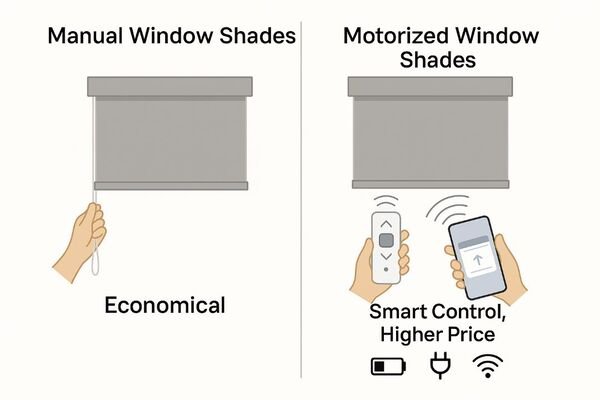
I know that when my B2B clients consider investing in high-quality roller shades, I always emphasize the long-term value, which far outweighs the initial cost. First, reduced energy consumption is a major benefit. High-performance roller shades, especially solar screen fabrics, effectively manage solar heat gain in summer and retain heat in winter. This means significantly lower HVAC operating costs over many years for commercial buildings. Automated shades enhance this further by dynamically responding to environmental changes. Shadesmart's solutions are designed for energy efficiency. Second, enhanced occupant comfort and productivity are invaluable. By controlling glare and optimizing natural light, high-quality shades create a more comfortable environment for employees or guests. This can lead to fewer eye strain complaints, better focus, and overall increased well-being and productivity. Third, an extended product lifespan minimizes replacement costs. Cheaper shades use inferior materials and mechanisms that wear out quickly. High-quality shades, built with durable fabrics and robust hardware, last much longer, reducing the frequency and cost of replacement and repairs. Fourth, superior durability reduces maintenance needs. Quality shades are often easier to clean and more resistant to damage from daily use, requiring less frequent servicing and lowering operational expenses. Finally, investing in premium roller shades contributes to an increased property value. They are seen as a modern, sophisticated, and energy-efficient amenity, enhancing the building's appeal and marketability. Over time, these combined advantages create a compelling return on investment.
| Long-Term Value | Description | Direct Impact for Businesses |
|---|---|---|
| Reduced Energy Consumption | Effective management of solar heat gain and loss, especially with automated shades. | Lower HVAC costs, significant operational savings over time. |
| Enhanced Comfort & Productivity | Glare control, optimized natural light, stable indoor temperatures. | Fewer complaints, improved employee satisfaction and focus. |
| Extended Product Lifespan | Durable fabrics, robust hardware, and reliable motors. | Reduces frequency and cost of replacements and repairs. |
| Superior Durability | Resistance to wear and tear, easy to clean, less prone to damage. | Lower ongoing maintenance costs, less downtime for repairs. |
| Increased Property Value | Modern, energy-efficient, and aesthetically pleasing amenity. | Enhances building appeal, yields higher rental income or resale value. |
| Brand Image & Aesthetics | Maintains a professional, high-end appearance for the commercial space. | Positive impression on clients and visitors. |
How does Shadesmart help businesses balance budget and performance for roller shade installations?
Are you trying to get good roller shades for your business without spending too much? Shadesmart can show you how to find the right balance.
Shadesmart helps businesses balance budget and performance for roller shade installations by providing detailed cost breakdowns, expert consultation for value engineering, offering scalable customization options, leveraging competitive wholesale pricing, and ensuring durable, high-ROI product selections backed by comprehensive project management.
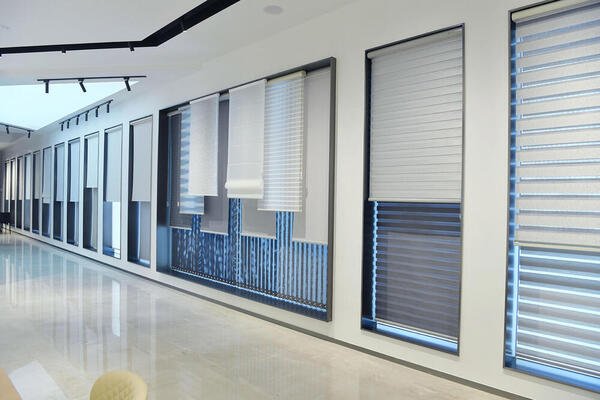
I know that striking the right balance between budget and performance for commercial roller shade installations is a priority for my clients, and Shadesmart is designed to optimize this. First, we provide detailed cost breakdowns. This transparency allows clients to see exactly where their money is going, making it easier to evaluate options and make informed decisions. Second, our expert consultation includes value engineering. We work closely with clients to identify alternatives or configurations that can achieve similar functional and aesthetic goals at a more favorable price point without compromising essential quality. For example, we might suggest using a standard motor in a less critical area to save costs, while still recommending a whisper-quiet motor for executive offices. Third, Shadesmart offers scalable customization options. We can tailor solutions to fit various budget levels, from high-end automated systems integrated with a BMS to simpler manual systems for common areas. This flexibility ensures that every dollar spent is maximized for impact. Fourth, as a wholesale provider with established factory partnerships since 2008, we secure competitive wholesale pricing for bulk orders. This translates directly into better per-unit costs for our B2B clients, enhancing their project's profitability. Finally, we ensure durable, high-ROI product selections. By focusing on quality fabrics and robust mechanisms, we help clients invest in shades that will last longer and perform better, reducing future maintenance and replacement costs. Our comprehensive project management supports this balance from initial concept to final installation.
| Shadesmart's Approach | Description | Direct Benefit to Businesses |
|---|---|---|
| Detailed Cost Breakdowns | Transparent, itemized pricing for fabrics, mechanisms, motors, and controls. | Clear understanding of costs, enables informed budget allocation. |
| Expert Value Engineering | Identifying cost-effective alternatives and strategic feature allocation. | Achieves desired performance and aesthetics within budget constraints. |
| Scalable Customization | Offering a range of options from basic manual to advanced motorized systems. | Flexibility to tailor solutions for diverse project needs and budgets. |
| Competitive Wholesale Pricing | Leveraging bulk purchasing power and factory partnerships for lower unit costs. | Improved project margins, maximizes budget efficiency. |
| High-ROI Product Selection | Guiding clients to durable, energy-efficient products that reduce long-term costs. | Lower maintenance, extended lifespan, strong return on investment. |
| Comprehensive Project Management | End-to-end support from consultation to final installation. | Streamlined process, ensures project stays on budget and on schedule. |
| Performance vs. Cost Analysis | Helping clients weigh upfront costs against long-term benefits and operational savings. | Justifies investment, demonstrates value beyond initial price. |
Conclusion
Roller shade costs vary by size, fabric, and operation. Fabric and mechanism choices significantly impact price and performance. High-quality shades offer long-term value through energy savings, comfort, and durability. Shadesmart helps balance budget and performance with transparent pricing, expert advice, and scalable, high-ROI solutions.

